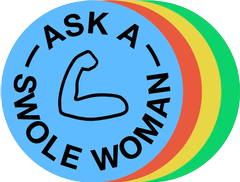Sick of clean eating, perfect gym outfits, and chiseled abs? A Swole Woman is here to help you be healthy, enjoy carbs, and get jacked.
Advertisement
Thanks,
JessHi, Jess! You have landed on one of the five pillars of Fears About Heavy Weights that companies selling baby dumbbells require to thrive; they need them like we need oxygen. The Fears About Heavy Weights are as follows:
JessHi, Jess! You have landed on one of the five pillars of Fears About Heavy Weights that companies selling baby dumbbells require to thrive; they need them like we need oxygen. The Fears About Heavy Weights are as follows:
- Heavy weights are only for already-strong/intense people (they are not)
- Heavy weights are difficult to learn or complex to use (more complex than some things, but a worthy investment in your ability to move around in the world)
- Heavy weights are unnecessary for modest fitness goals, and don’t burn calories as well as lighter weights (completely false)
- Heavy weights produce a “bulky” look (wrong)
- Heavy weights can cause injury, and are thus scary and dangerous (vastly overblown)
Advertisement
To understand why “heavy” matters, it’s useful to look at the other end of the weights spectrum, what they do and what their existence and the way they are marketed means. I’m talking about the tiny baby weights, the itty bitty 2-pound dumbbells, the 1-pound wrist or ankle cuffs that have haunted me since the Jane Fonda days, when little blue canvas wrist weights with nylon straps spooked around my childhood home. One brand of tiny weights in particular has been showing up in social media feeds lately with its literal $50 one-pound wrist weights. Why use big weights when small ones seem both less scary and still difficult? If a Peloton instructor or Kayla Itsines’ Sweat app coach uses small dumbbells, does that not mean we should all follow their example? (Short answer: No, because her heavy weight lifting is the reason she looks the way she does, but let’s keep going.)Harvard Health affirms about wrist weights what I suspect is often true about many mainstream exercise things: They are actually designed for elderly people and/or people with disabilities. (“‘They're great for targeted exercise if you can't grip a dumbbell,’ Downey says. For example, you might have a weak grip from arthritis or a stroke.”) And if you don’t lift with them and instead just go around wearing them while walking or whatever, it’s actually bad for your body.
Advertisement
I have worked out with tiny dumbbells and done body-weight workouts at home in the past, and at the time it felt difficult; these workouts made me sweaty, and my muscles hurt the next day. So I was incredibly skeptical when I started lifting that I would ever be able to work with anything heavier, when the small weights were already hard and a handful of crunches made me very sore. But the key was that my body was ready to grow; in fact, I really badly needed it. I didn’t need to just move around; after losing a lot of strength and muscle from years of casual-to-aggressive dieting, I needed muscle. After losing more and more mobility from sitting at a desk job, I needed movement skills.While 15-pound weights felt heavy at first, the next week I could lift 20 pounds just as well, and 25 the week after that. After a month of progressively overloading the six exercises I was doing only for sets of five, I had maybe only exchanged one pound of body fat for muscle, but I could squat 65 pounds for five reps; I was eating way more food to fuel my growth; and the way I moved all of the time felt completely different.Now I have more abs than I ever did when I weighed 40 pounds less, and I haven’t done a crunch in years. All this is to say: If I could round them all up, I would drop-kick every small pink dumbbell into the sea. Companies that sell you, say, a $100 15-pound weight that looks like abstract art (looking at you, Goop) are trying to keep you where you are, not trying to help you grow.
Advertisement
Do you want to learn to lift weights? Join the Swole Woman Discord. Have a question about working out, eating, health, or why you shouldn't be afraid of lifting heavy? Send it to swole.woman@vice.com and follow @swolewoman on Instagram.For a young-ish person of sound body, a 1- or 2-pound weight is almost meaningless. A 1-pound weight uses not even one percent of your strength potential. You are giving your body a Wheat Thin when it wants the whole meal. Not only are small weights too small—literally, it is blowing my mind that they exist, because they actually could not be any smaller; they are beyond even the booty band’s level of questionable—they fake us out in a specific way. Doing any exercise can feel hard, but only some exercise does more than “make you sweat a little.” (To be clear, sweating is a fine goal, but if you’ve ever expected more from working out and been confused why you aren’t getting it, it’s likely because you are capable of being challenged more in the right ways.) But the problem with small weights is that they can make us think we’re hitting the mark of strength training, without being intense enough to get us there.
Advertisement
The key to building strength is that you are never actually doing more than you can handle—but you can likely handle a lot more than you think you can. The fitfluencers of the world will try to scare you about heavy weights and tell you you should be afwaid, that very light or bodyweight stuff is the same. It isn’t. (Young people on TikTok actually seem to understand this a bit better, or at least I see them going viral for using heavy weights quite a bit, and good for them!!) But you should start with what you can manage and build from there. If you feel like you can’t even lift a weight into the air, or squat it, or deadlift it even once, it's too heavy for now. That’s OK! If that’s the case, go down by 10 percent or five pounds, whichever is greater, and try the higher weight again next session or week.
Advertisement
On the specific safety tip, obviously there is some danger in lifting anything above your head. Dumbbells are actually trickier in this respect, because trying to handle two different weights at a time is harder than a single barbell, which is part of the reason that heavy lifting tends to revolve around barbells! You might be getting to the point where it’s time to make the switch (or keep working with weights you can safely manage, but your growth will be limited while you’re still new at this).As you get stronger, dumbbells are great for accessory stuff, but it’s still easier, safer, and more straightforward to use a barbell for lifts. If you haven’t considered moving up to a barbell and dumbbells are starting to feel unmanageable, it might be barbell time. Barbells can also be managed by “safeties,” or rests on either side of a rack that will catch them so they don’t land on your body when you fail; or by “spotters,” people who supervise your lift and help you if you start to fail. You should take advantage of both of these, if your gym has them (a spotter can be “any other friendly gymgoer”).
Advertisement
Secondly, what you are looking for is “safe ways to fail,” or ways to bail on a movement when it goes awry. Lifters have been developing bailing methods for decades, and actually, weight lifting has among the lowest injury rates of virtually all sports. You are far safer lifting than you are, say, playing a game of rec soccer. You can practice safe failing by using lighter weights (which basically means any weight that doesn’t scare you) to do the move you’re afraid of. Practice dropping the lighter dumbbells onto the ground in the right direction, or throwing your body forward when you fail a squat so the barbell falls back and away from you instead of over your neck and head. You can also practice “the roll of shame” during a bench, where you lower the bar safely and then roll it down your body until you can stand up. Whatever lift it is that you’re afraid of, your search terms are “how to fail [the lift in question]” to find info or videos that will help you. I can’t promise you’ll never hurt yourself—I personally have a bias towards dropping plates on my feet, which hurts like a bitch even when they are tiny ones—but hopefully you will feel reassured by the fact that it’s easier to fail safely than you might think, and it’s even part of the whole journey. And definitely don’t let this keep you from upping your weights; not only because The Man’s greatest hope is for you to stay afraid, but because, speaking from experience, it might be the greatest thing to ever happen to you. Disclaimer: Casey Johnston is not a doctor, nutritionist, dietitian, personal trainer, physiotherapist, psychotherapist, doctor, or lawyer; she is simply someone who has done a lot of, and read a lot about, lifting weights.You can read past Ask A Swole Woman columns at The Hairpin and at SELF and follow A Swole Woman on Instagram. Got a question for her? Email swole.woman@vice.com.

